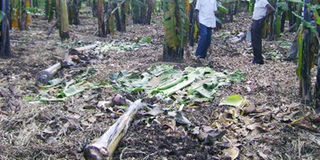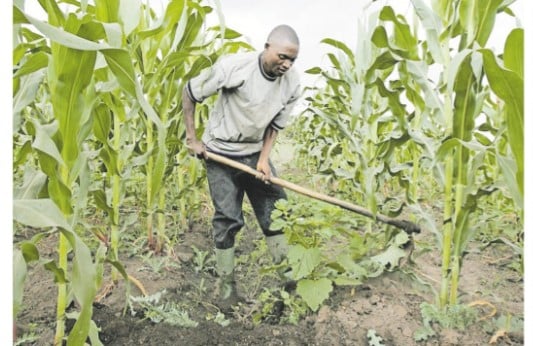Prime
Banana bacteria wilt rages on

Mzee Boniface Muntukwonka tours part of his plantation that has been cleared due to the disease. PHOTO BY GEOFFREY MUTEGEKI
What you need to know:
Geoffrey Mutegeki highlights the plight of Kabarole farmers whose production is being affected by the Banana Bacteria Wilt disease
As the Banana Bacteria Wilt (BBW) continues to rage in different parts of Kabarole district, farmers are appealing to government for swift intervention since the outbreak has greatly affected their production.
Some of the farmers in Rwengaaju parish, Busoro Sub County in Kabarole district say the disease is greatly threatening their livelihood because their banana plantations are their basic source of food and income to meet other requirements such as schools fees.
Mzee Boniface Muntukwonka, 77, a resident of Nyakahindo in Busoro Sub County says the disease attacked his plantation about three months ago and is almost finishing his plantation.
“It is now three months since the disease attacked my plantation, every day I cut down four to six plants. The wilt was reported in Kijura, Hakibale Sub County but now it has crossed here,” he says.
He adds, “Some leaders from government have been telling us about the preventative measures like cutting down infected plants and burying them under heaped earth, cleaning tools either with Jik or in a flame of fire and restricting movement of plant materials. I have tried to apply them but it’s are not working out,” Muntukwonka says.
He believes that his neighbours are letting him down in the fight against the disease because they don’t follow any safety measures.
“My neighbours are stubborn; they have continued not to look after their plantations which has increased the spread” he says, adding, “When you clear your plantation in a bid to stop the spread of the disease and the neighbour fails to follow, you are doing nothing.”
Mzee Muntukwonka who heads a family of 13 people says his banana plantation is his only source of income and food.
“I had planned my plantation to help me in my aging days, but now all seems to be bad for me, I cannot get school fees for my grand children. All my children died and I have to look after my grand children. The wilt is confusing me, I don’t know what to give my grandchildren,” he says.
He adds, “The government should help us, this is my only source of income. I cannot be employed or do other things, I depend only on matooke.”
Mr Bernado Byaruhanga, 67, a resident of the same area says Naads last year sensitised them on how to prevent BBW but said he has applied all the measures to fight the disease but it’s not working.
“My plantation helps me get money for my children’s school fees. I have a family of 21 and they are all fed by the plantation but now the wilt is competing with me,” he says.
He adds, “I cannot afford buying dry food from the market due to high prices and it’s not possible for me to plant other plants. My land is small and other plants cannot do well here all year round.”
Ms Mwajuma Baragaija, another farmer in Rwengaju says despite cutting down the affected banana stems, the disease has persistently spread to the rest of her banana plantation.
In 2006, the Kabarole district BBW task force in collaboration with Naads service providers and Village Task Forces worked aggressively to contain the disease in one of the affected villages (44 households) in Mugusu sub-county.
The farmers say the acute nature of the disease ruins the fruit, making them inedible even to livestock and eventually kills the banana plant itself.
How it spreads
Insects are thought to be the most common vector of transmission at the field level. Infected plants produce characteristic ooze, rich in the bacteria, which drips from natural scars associated with the male bud of the plant. Insects feeding on the bud carry the bacteria to other uninfected plants.
Browsing livestock can also spread the disease.
Spreading over longer distances is more likely to be by humans. For example, bacteria can easily be carried on tools used to cut infected plants, so a farmer may inadvertently transfer the disease while trying to control it. And once a plant is infected, suckers produced from the banana ‘stool’ also harbour the disease; these may be harvested as planting material and in this way take the problem to previously uninfected areas.
Control measures
Cut down infected plants and burying them under heaped earth,
Clean tools either with a household cleaning product (Jik) or in fire.
Restrict movement of plant materials.
Farmers are also encouraged to limit the opportunities for the disease to spread in their fields by breaking off the male buds from their banana plants. Through the slogan, “Castrate: Twist and Break” farmers learn that “castrating” their bananas, prevents them from getting sick, a message that undoubtedly raises smiles, but is also not easily forgotten.
In the zone where the disease is not yet prevalent, the emphasis is on prevention: removal of male buds and not allowing materials from infected zones to enter the area. That can be difficult when banana fruits and trash are transported to large distances within Uganda.
Sensitisation of farmers on the spread of the disease and educating them on some simple control measures.




